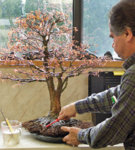A week or so ago, we had a lively discussion on whether apexes of trees should extend towards the viewer. And there were a. Purple other aspects of bonsai design brought up as well.
I came across this video published by Bonsai Empire that is a preview of one of Bjorn’s video tutorials. I thought it was excellent.
It’s primarily on the design aspects of conifers, but much of what he talks about is universal.
It’s well worth watching.
I came across this video published by Bonsai Empire that is a preview of one of Bjorn’s video tutorials. I thought it was excellent.
It’s primarily on the design aspects of conifers, but much of what he talks about is universal.
It’s well worth watching.


